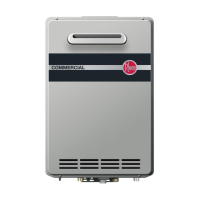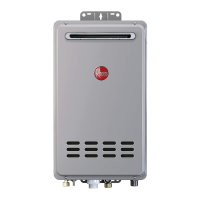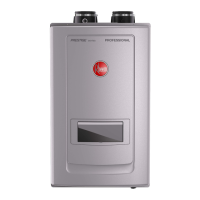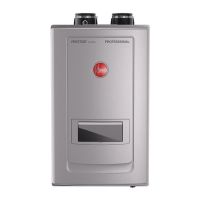35
INSTALLATION INSTRUCTIONS
Venting
Recommended Vent Lengths
Before starting the vent installation, careful planning
should be given to the routing and termination of the
vent pipes. The length of the vent pipes (air intake and
exhaust) should be kept to a minimum. Also, see pages
38–39 and 45 for vent terminal placement. Refer to the
maximum and minimum vent length charts for the pipe
sizes that can be used and the total equivalent length of
pipe that can be used. Do not exceed equivalent length
of pipe in maximum vent length chart.
Maximum Vent Length (airintake/exhaust) each:
Number of
90° Elbows
Maximum Length
of 2" Straight Pipe
Maximum Length
of 3" Straight Pipe
Maximum Length
of 4" Straight Pipe
1 5.0 ft. (1.5 m) 38.0 ft. (11.6 m) 94.0 ft. (28.7 m)
2 3.5 ft. (1.0 m) 36.5 ft. (11.1 m) 88.0 ft. (26.8 m)
3 2.0 ft. (0.6 m) 35.0 ft. (10.6 m) 82.0 ft. (25.0 m)
4 Not available 33.5 ft. (10.2 m) 76.0 ft. (23.2 m)
5 Not available 32.0 ft. (9.8 m) 70.0 ft. (21.3 m)
6 Not available 30.5 ft. (9.3 m) 64.0 ft. (19.5 m)
The system will not operate if there is excessive
restriction (pressure drop) in the venting system. Use
the chart above to calculate the maximum pipe run
length with the required number of elbows (e.g., a
maximum 38 ft. [12 m] of 3" vent pipe may be used
provided there is only one 90° elbow in the system).
A 90° elbow is equivalent to 1 ft. 6 in. (0.5 m) of 2" or 3"
straight pipe, and to 6 ft. (1.8 m) of 4" straight pipe. A
45° elbow is equivalent to 9” (0.25 m) of 2" or 3" straight
pipe, and to 3 ft. (0.9 m) of 4" straight pipe.
The vent termination does not count as part of the straight
pipe equivalent when determining the total vent length.
Minimum Vent Length:
Number of
90° Elbows
Minimum Length
of 2" or 3" Straight
Pipe
Minimum Length
of 4" Straight
Pipe
1 1.0 ft. (0.3 m) 38.0 ft. (11.6 m)
NOTICE:
To use 2" or 4" vent pipe, a reducing adapter or an
increasing adapter will be required.
WARNING:
To use Category III Stainless Steel, a proper transition part
will be required to prevent flue gas from leaking.
Depending on the size of pipe that is chosen for venting
the water heater, it might be necessary to use a fitting
for stepping down in pipe size, to connect to the water
heater.
All intake and exhaust venting components must have
the same diameter size. DO NOT use a different size
on the intake and exhaust venting.
The unit may be vented horizontally through a wall
or vertically through the roof. Pipe runs must be
adequately supported along both vertical and horizontal
runs. Maximum unsupported span is recommended
to be no more than 4 feet (1.2 m). It is imperative
that the first hanger be located on the horizontal runs
immediately adjacent to the first 90-degree elbow from
the vertical rise. Only use support isolation hanging
bands. DO NOT use wire to support pipe runs.
Stress levels in the pipe and fittings can be significantly
increased by improper installation. If rigid pipe clamps
are used to hold the pipe in place, or if the pipe cannot
move freely through a wall penetration, the pipe may
be directly stressed, or high thermal stresses may be
formed when the pipe heats up and expands. Install
accordingly to minimize such stresses.
Venting for Direct-Vent Water Heater

